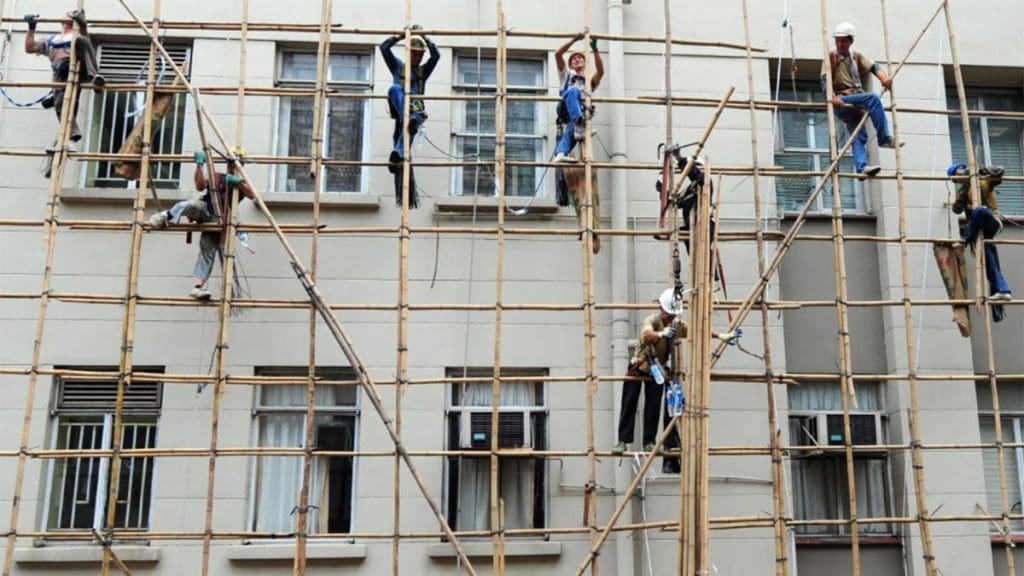The Advantages of Scaffolding for Safety And Security and Effectiveness in Structure Projects
Scaffolding is a vital component in the realm of construction, substantially contributing to both safety and security and operational performance. The impact of scaffolding expands past fundamental security actions; its strategic implementation can change task timelines and end results (Scaffolding).
Enhanced Worker Security

Improved employee safety is an extremely important issue in the construction sector, where the risks connected with drops and mishaps can have alarming consequences. Effective scaffolding systems play a crucial duty in mitigating these hazards by giving steady systems for workers at elevated elevations. By making certain that scaffolding is correctly erected and maintained, building and construction companies can significantly minimize the probability of falls, which are amongst the leading root causes of work environment injuries and fatalities.
Moreover, scaffolding improves security with its layout attributes. Guardrails, toe boards, and non-slip surface areas contribute to a protected workplace, minimizing the threat of accidents. In addition, scaffolding permits workers to access hard-to-reach locations without the demand for makeshift solutions, which can endanger security requirements.
Training workers on the proper use scaffolding is just as vital. Making certain that personnel are experienced concerning lots capabilities, assembly procedures, and safety procedures better enhances the effectiveness of scaffolding in avoiding crashes. To conclude, integrating robust scaffolding systems within building tasks not only enhances worker safety but additionally promotes a society of safety and security that benefits the whole workforce while enhancing general productivity.
Improved Accessibility and Mobility

Moreover, scaffolding permits the practical transport of devices and materials, reducing downtime connected with relocating equipment. Workers can efficiently access numerous areas of a task, which is especially important in complex builds where upright and horizontal motion is regular - Scaffolding. This accessibility not only enhances procedures yet likewise makes it possible for teams to react promptly to altering task needs
Additionally, scaffolding can be tailored to accommodate details website conditions, boosting mobility in limited or uneven spaces. This flexibility ensures that building activities can continue efficiently, no matter the challenges presented by the setting. By cultivating improved access and flexibility, scaffolding plays an important role in sustaining building staffs and maximizing the overall efficiency of structure tasks.
Raised Project Efficiency
In building and construction, job effectiveness is considerably affected by the efficient use scaffolding systems. By supplying a safe and stable system for employees, scaffolding reduces downtime and speeds up the speed of building and construction tasks. With better accessibility to raised workspace, teams can complete jobs quicker, lowering the total project timeline.
The modular nature of contemporary scaffolding enables quick setting up and disassembly, allowing speedy changes in between different stages of a task. This adaptability not only improves workflow however additionally adds to much better sychronisation among numerous professions, as several groups can function simultaneously on various sections of a structure.
Furthermore, scaffolding guarantees that workers are located properly to perform their jobs without unnecessary pressure or danger of injury, consequently minimizing the probability of mishaps that can result in expensive delays. Enhanced safety steps embedded in scaffolding systems, such as guardrails and toe boards, further support effective operations by maintaining worker concentrate on the job available as opposed to safety issues.

Convenience for Numerous Projects
Scaffolding systems stick out for their adaptability across a large range of building and construction jobs, efficient in conference certain site needs and jobs. Their modular style enables fast adjustments to suit various structure types, from household to industrial structures, making sure that employees have risk-free gain access to at different elevations and angles.
These systems can be tailored for varied applications, such as façade work, indoor restorations, or heavy-duty commercial jobs. As an example, light-weight aluminum scaffolds are optimal for indoor work, while durable steel frameworks provide the needed support for large building and construction. The adaptability of scaffolding extends to its capacity to be configured for both momentary and irreversible structures, permitting visit this website specialists to effectively prepare and execute their projects.
Additionally, scaffolding can be used in difficult settings, consisting of city settings where area is restricted or on uneven terrain where typical access services are not practical. This versatility lessens the need for several gain access to remedies, lowering expenses and job timelines. By suiting a selection of tasks and problems, scaffolding boosts the total efficiency and effectiveness of construction efforts, confirming to be an essential property in the structure sector.
Compliance With Safety And Security Standards
Exactly how can construction jobs guarantee the safety of employees while preserving efficiency? Conformity with security requirements is critical in accomplishing this balance. Regulative frameworks, such as OSHA in the United States, give standards that regulate making use of scaffolding, making sure that it meets stringent security standards. By sticking to these criteria, construction firms can lessen the threat of mishaps, which not just protects workers yet additionally boosts total project effectiveness.
Appropriate scaffolding style and installation play an essential duty in compliance. Training workers on secure scaffold use and the value of conformity with security standards even more reinforces a society of safety on-site.
Furthermore, paperwork and record-keeping pertaining to safety and scaffolder meaning in punjabi security evaluations and worker training are vital. These practices not only demonstrate compliance but additionally give responsibility and transparency. Eventually, by focusing on adherence to safety standards, building jobs can cultivate a safer job environment, thereby boosting efficiency and performance without jeopardizing employee safety and security.
Verdict
In final thought, scaffolding works as an essential part in structure tasks, substantially enhancing safety and efficiency. Its layout features, consisting of guardrails and non-slip surface areas, contribute to a more secure working environment while helping with enhanced access and movement for employees. The modular nature of scaffolding advertises quick assembly, hence increasing overall task efficiency. Moreover, adherence to safety standards emphasizes the significance of scaffolding in achieving effective job outcomes, making it crucial in the building industry.
Scaffolding is a vital part in the world of building, dramatically adding to both safety and functional effectiveness. The influence of scaffolding extends past standard safety and security actions; its tactical implementation can transform job timelines and outcomes. In final thought, incorporating durable scaffolding systems within building and construction jobs not only boosts employee security but also advertises a society of security that benefits the entire labor force while boosting total efficiency.
In verdict, scaffolding offers as a crucial part in building projects, dramatically enhancing safety and efficiency. Adherence to safety and security requirements emphasizes click here for more info the importance of scaffolding in accomplishing successful job end results, making it indispensable in the building and construction sector.